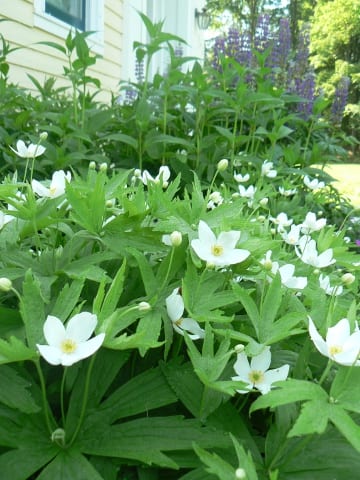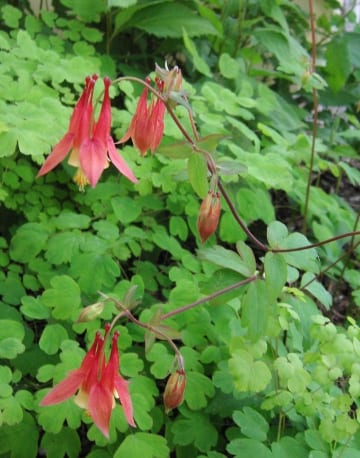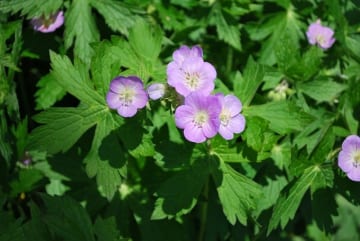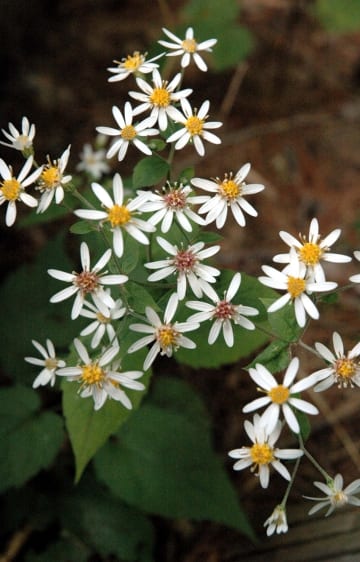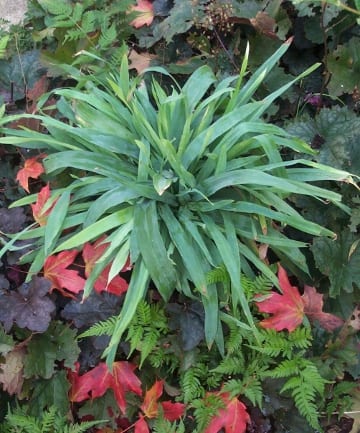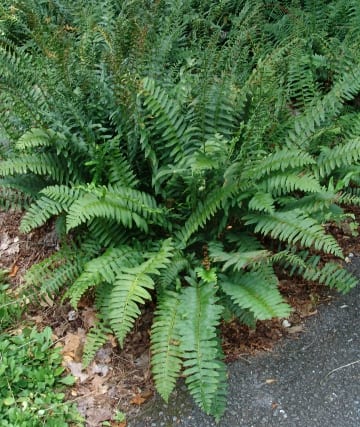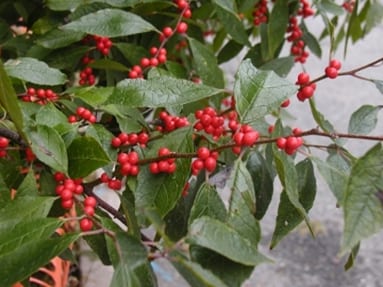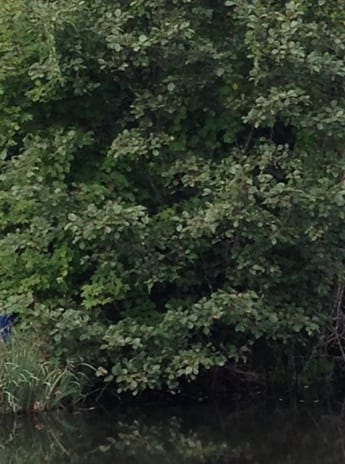Wet or dry, sunny or shady…. Site conditions can determine whether or not a plant survives beyond a single season. If you’re designing with native plants, you’ll want to be sure to site plants so that they’ll be reliable hosts for the wildlife that relies upon them. Two plant nurseries make their recommendations for native plants suited to two particular sites.
Native Plants for Dry Shade
by E. Roxanne Gawthrop, shopkeeper at Project Native, a non-profit native plant nursery in Housatonic, MA. Roxanne may be reached at rgawthrop@projectnative.org.
Areas of dry shade are often thought of as difficult gardening situations, but they needn’t be, with so many beautiful native plants well suited to such spots. Whether on the north side of your house, out in the yard under a large tree, or in adjacent woodland, here is a survey of suitable plants native to the northeastern United States that provide interest throughout the growing season and value for wildlife all year round.
Keep in mind that “dry” is relative. The northeastern U.S. receives quite a bit of precipitation per year, but in “dry spots” it is not retained by the soil. In general, these natives need to be watered until established, and then should be fine unless there is an extended drought.
Groundcovers
A number of low-growing native species make attractive groundcovers in dry shade. The glossy strawberry-like leaves of barren strawberry (Waldsteinia fragarioides) form a six-inch-high carpet of bright green above which pretty yellow flowers appear. Its fruits are inedible. Barren strawberry spreads by rhizomes and can be divided.
Wintergreen (Gaultheria procumbens) is a creeping woody groundcover that prefers acidic soil. It spreads by underground stems and grows to six inches in height. Dainty white or pink flowers dangle from the leaf axils and develop into waxy red berries.
Pachysandra procumbens, or Allegheny spurge, forms a slowly-enlarging clump of handsome serrated leaves and produces short spikes of white flowers in the spring.
A more rambunctious groundcover, Canada anemone (Anemone canadensis) spreads freely (perhaps too freely in sunnier, moist sites), creating a bed of lacy green foliage from which stems with lovely, five-petaled white blossoms appear in early summer.
Taller Choices
Commonplace but wonderful, the woody vine Parthenocissus quinquefolia, Virginia creeper,rambles happily along the ground, over stone walls, and harmlessly up vertical surfaces, covering many linear feet in a season, and turning a gorgeous crimson in the fall. It is a larval host to several species of moth, and its berries are relished by many birds.
The ornate red and yellow blossoms of wild columbine (Aquilegia canadensis) nod above bluish-green leaves and provide nectar for ruby-throated hummingbirds migrating northward in the spring. It is a cheerful self-sower and is the larval host of the columbine duskywing butterfly.
Bigleaf aster (Eurybia macrophylla) grows to three feet, but nevertheless makes an effective groundcover in shade because of the size of its lower leaves, which can be several inches across. This aster is a larval host to the pearl crescent butterfly, and produces sprays of lavender or white flowers.
The deeply lobed leaves of cranesbill (Geranium maculatum) give rise to five-petaled, rosy-lavender blossoms which are attractive to native bees. The seeds are designed to spring away from the plant upon ripening, so watch for volunteers in the vicinity.
White wood aster (Eurybia divaricata) has heart-shaped leaves and grows only a foot or two tall so doesn’t need staking. It starts blooming earlier in summer than most asters, and the slender petals of its white flowers spangle shady areas like delicate stars.
Later in the season, cheerful yellow blossoms appear on woodland sunflower (Helianthus divaricatus) and sway on slender, lanky three-to-five-foot stems.
Some goldenrods grow well in shade. Solidago flexicaulis is called zigzag goldenrod because its stem grows in alternate directions above each leaf node. Delicate yellow flowers appear near the top of the two-foot-tall stems.
Wreath goldenrod, Solidago caesia, has small clusters of yellow flowers along most of the length of its gracefully arching stems. Goldenrod flowers attract bees and butterflies, and their seeds provide food for birds and mice.
While everything else is attracting attention during the growing season, white snakeroot (Ageratina altissima) grows several feet tall but is often overlooked. Then it blooms ― and with its clusters of fuzzy white flowers, it seems to be everywhere!
For Foliage
Other native plants for dry shade are noted more for their foliage than flowers. Pennsylvania sedge (Carex pensylvanica) has wispy, grasslike leaves and expands by rhizomes to form a soft-textured, wind-swept ocean of green. The more robust grey-green leaves of silver sedge (C. platyphylla) fan out from the center of the clump in a somewhat stiff spray, while the more relaxed, puckered, bright green leaves of plantainleaf sedge (C. plantaginea) are reminiscent of seersucker fabric.
A dry-shade plant with bodacious foliage is mayapple (Podophyllum peltatum), whose large, palmate leaves rise twelve-or-so inches above spreading rhizomes and unfurl like ragged umbrellas. It forms large colonies and needs room to roam. Mayapple does produce flowers and fruit but they remain well hidden beneath the leaves.
And finally, a good fern for shady dry situations is Christmas fern (Polystichum acrostichoides), which has leathery dark green leaves that do not lose their color in winter.
So many choices! Hopefully you have a lot of dry shade!
Native Shrubs for Sunny yet Wet Locations
by Sabrina Cutting, the owner of Sudbury Nurseries West, LLC., a third generation wholesale nursery dedicated to the propagation of local ecotype native plants and conifers located in the town of Gill, MA. Sabrina can be reached at 413-863-9898 or gscut@crocker.com.
Sun-loving plants abound, but what about plants for that sunny area that is almost always wet? Many of the best choices for wet areas are native choices. At Sudbury Nurseries in Gill, (UDSA hardiness zone 5b) northern Franklin County, MA, we grow a number of native-born shrubs and trees that will thrive in that sunny, yet damp, location.
Cornus amomum (Silky Dogwood) is a deciduous, medium-sized shrub that often reaches 5- 8’ in height. It is fast growing and maintains an upright, rounded habit. Young dogwoods have reddish stems in the fall into winter, and turn reddish-brown in summer. As the shrub matures, the stems turn reddish-brown all year and finally gray. Although not a specimen plant it offers lots of pluses: it forms thickets that provide nesting and cover for birds, it has attractive blue fruit in the fall that are a food source for many animals, it supports beneficial predatory or parasitoid insects that prey upon pest insects, and it is a good solution for controlling erosion. Its soil “requirements” range from clay to sand.
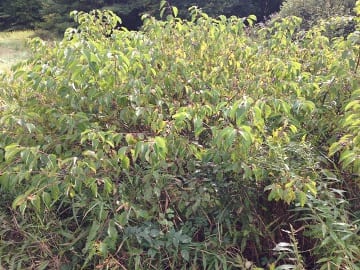
Silky dogwood (Cornus amomum) provides excellent habitat for birds and animals.
Lyonia ligustrina (Maleberry) becomes a dense deciduous shrub of small size, typically growing 3-6’ in height and twice as wide. The glossy green leaves become orange-red in the fall, finally turning tan and persisting through much of the winter. Maleberry spreads from heavily branching rhizomes. It produces small, white flowers similar to blueberry, but produces hard, dry capsules rather than fleshy fruit. This is a good choice for fire-prone habitats, as it will bud and send up shoots from the rhizome if the aboveground plant has burned. Maleberry has no serious disease, insect or physiological problems.
Ilex verticillata (Winterberry) is a globular, upright, shrub typically 6-10’ tall. Very adaptable to wet and dry sites and is a great naturalizer. Unlike other hollies, Winterberry leaves are not shaped with sharp “teeth” nor is it ever green. This is a dioecious (separate male and female plants) shrub with dense branches that sport showy bright red fruit (on the female) that persists throughout the winter. This ornamental feature, plus the fact that it can be pruned for size, makes it a popular plant for the landscape. Winterberry also provides a food source for many small mammals and over forty species of bird. It is recommended by the Xerces Society as having special value to honey bees and the Elf butterfly. Winterberry has no serious disease, insect or physiological problems.
Spiraea latifolia (Meadowsweet) grows as a low, mounded shrub of 2-4’ in height. Broad oblong leaves that are shiny-green in summer turn golden yellow in the fall. White to pinkish flowers are arranged in elongated, terminal spikes and bloom from mid to late summer. They attract bees and butterflies and also support beneficial predatory or parasitoid insects that prey upon pest insects.

Meadowsweet (Spiraea latifolia) displays small white to pink flowers in midsummer and golden foliage in fall.
Alnus incana (Speckled Alder) reaches 25 feet in height. This fast-growing shrub/tree is somewhat short-lived (40-years). It often branches at the base in wide curves maturing into upright and picturesque trunks. The flower is a purplish-red catkin, and the fruit is a woody cone. Speckled alder forms an attractive and functional thicket that provides cover for small and large mammals, food for birds, and erosion control along waterways. As a bonus, Alder’s root nodules support nitrogen-fixing bacteria.
Vaccinium corymbosum (Highbush Blueberry) is a medium shrub of 12 feet with a wide and upright stems and twiggy branches forming a round, compact outline. Blueberry’s showy and fragrant white flowers, beautiful red fall color and edible fruit make it attractive to a variety of wildlife, as well as to human foragers. This is a very adaptable shrub. Light requirements range from sun to shade (for best fruiting and fall color plant in full sun) and soil moisture from wet to dry. Blueberries, like all members of the Ericaceae family, is extremely susceptible to chlorosis due to alkalinity, so make sure it’s planted in acidic soil (pH <6). Blueberry is useful for naturalizing, and multiple plants form a beautiful shrub border.

